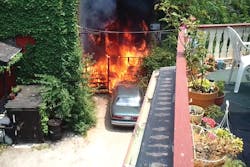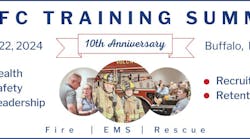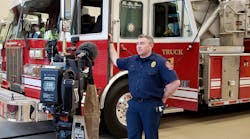“One civilian fatality, seven firefighters injured, Mayday and the rescue of a lost, unconscious firefighter, complete building loss...” Firefighters in Oconomowoc, WI, are breathing sigh of relief after a close call as one of their own narrowly escaped a fire with his life.
On Sunday, July 1, 2012 at 12:54 P.M., the Oconomowoc Fire Department (OFD) was dispatched for a report of a structure fire with victims trapped in the second-floor apartment at 112 North Main St. The weather was sunny and clear with a temperature of 89 degrees and a heat index of 94 degrees.
Oconomowoc is in Waukesha County in southeastern Wisconsin. The department protects a fire and EMS service area of 22 square miles with a population of 21,809 and an additional EMS area of nine square miles and 3,261 population; the total area covered totals 31 square miles and a population of 25,070. The membership consists of 52 paid-on-call members and six full-time personnel (Monday to Friday, 8 A.M. to 4 P.M.) that includes a deputy chief, a lieutenant and four firefighter/paramedics.
OFD apparatus includes two engines, one 100-foot aerial platform, two ambulances, one grass rig, one command unit, two support units, a dive van and boat, one light rescue (rapid intervention crew vehicle) and one water tender. In 2011, the OFD responded to 384 fire calls and 1,428 EMS calls.
For their submission, participation and cooperation in this column, I thank all the members of the OFD, especially Lieutenant Mike LaVenture, who was the trapped firefighter, and Firefighters Kevin Jezak and Bob Diehn, who made entry to assist the lieutenant. Further thanks to Firefighter/Paramedic Adam May, Deputy Chief Glenn Leidel, Public Safety Director David Beguhn and the entire Western Waukesha Rapid Intervention Crew. Thanks also to the numerous fire departments, rehab units, EMS, law enforcement, strike teams and related agencies that responded to this fire-unfortunately space restricts us from listing all of them. Additionally, a special thanks to all the members and the leadership of MABAS and its CEO, Chief Jay Reardon, for the “mutual aid” assistance in this column as well.
Initial response, size-up and operations
112 North Main St. is a typical two-story, ordinary-construction, taxpayer-type building. It consists of an office with a small kitchen on the first floor and two apartments on the second floor. It is mid-block with other similarly constructed buildings attached to it. It was built in the late 1800s with several remodels throughout the years. Each floor measures approximately 1,500 square feet.
At that time of dispatch, the senior fire officer, Deputy Chief Glenn Leidel, was two blocks away at his local church. While responding, he initiated a Mutual Aid Box Alarm System (MABAS) box to the first-alarm level within minutes of the initial tone. He did this due to radio traffic and visible smoke prior to arrival.
On arrival, while driving past the A side of the building, Leidel noted civilians attempting to rescue a victim from a second-story window using a ladder, as the stairwell was involved in fire. He drove to the back of the building to attempt to complete his 360-degree walk-around. On side C side he found a large body of fire on the exterior of the building extending to two cars and an attached exposure building on side D.
Initial radio traffic between Leidel and the first officer at the fire station was to respond with the aerial platform first. Ladder 4771 responded in five minutes and was on scene in seven minutes. Leidel ordered the apparatus to park on East Wisconsin Avenue. No other radio traffic was heard by the lieutenant as to the incident action plan (IAP).
The crew of Ladder 4771 was bombarded by civilians screaming, crying and asking the firefighters to go around the block to the front of the building. The lieutenant made the decision for the crew to take a 24-foot ground ladder to the front of the building to take over the civilian rescue. From where they had parked, the crew had to walk approximately 300 feet to the front of the building. Since the ladder crew walked around side A to attempt rescue, the deputy chief pulled a three-inch handline and attempted a “blitz” attack on side C with the 200 gallons of tank water.
Before Ladder 4771 laddered the window on side A, a civilian ladder was placed and a bystander climbed it. He assisted with the rescue of the first trapped person, who made it out the widow by falling into the arms of a police officer and several bystanders. The civilian was then attempting to rescue the still conscious second and last victim. As Ladder 4771’s crew laddered the window and removed the civilian rescuer, they saw the victim take a breath and fall backwards into the smoke-filled room.
Two firefighters and the lieutenant climbed the ladder and entered the room through the already-broken window. They did not have the protection of a hoseline and, while searching, experienced high heat and zero-visibility smoke. They immediately found the victim since she was just a few feet into the room. They moved her to the window sill and one firefighter exited onto the ladder to extricate her. The crew was unable to transfer the victim to the ladder due to her being obese and wet from blood and sweat and because the window sill was taller than average.
At this time, an interior firefighter’s low-air alarm sounded and he exited. He was replaced by a firefighter from the second-arriving engine. The lieutenant stayed in the building with the victim. They too were unable to extricate the victim through the window. A new plan was made by the interior firefighter and lieutenant to attempt to drag the patient to the rear exit stairwell. The firefighter confirmed that the path was clear of fire and placed a one-inch nylon strap over the victim’s torso. The lieutenant and firefighter then began dragging the victim to the rear stairwell, on side C of the building.
A fire officer becomes trapped
During the second attempt at removal of the victim, a dramatic life-changing event occurred. The interior crew experienced horrific high heat and the strap around the victim slipped off, causing the firefighter and the lieutenant to fall in opposite directions. They became separated and confused as to where they were in the building, but each had a portable radio. The firefighter made his way back to the A-side window and exited, thinking the lieutenant was right behind him. He was not. The firefighter stayed by the window, banging on the wall and floor and calling out for the lieutenant with no response.
The lieutenant, now alone inside the kitchen, attempted to extricate himself several times. Still experiencing high heat and zero visibility, he again located the victim. Knowing which way she was orientated and the direction toward the exit window, he found her feet and attempted to proceed to the window. While doing this, however, his low-air alarmed sounded and he knew he was in trouble. After several attempts to find the window, the lieutenant realized he needed help and called a Mayday on his radio. After transmitting the Mayday, he found a small room, shut the door, hunkered down and waited to be rescued. He eventually ran out of air, so he pulled his hood up over his nose and mouth in an attempt to reduce breathing in the smoke. While awaiting the rescue, he eventually slipped into unconsciousness.
The Mayday was heard the first time by command (the deputy chief). While the dispatchers do not monitor the fireground, the deputy chief repeated the emergency on the dispatch channel. The rapid intervention crew (RIC) was just arriving on scene with its initial light-duty rescue truck staffed with three firefighters. The RIC that made entry was pieced together from other RIC members who came on Oconomowoc apparatus and who are RIC trained. At this point, the RIC had not yet sized-up the fire or set up its equipment. The RIC was quickly placed into service and made entry the A-side, second-floor window.
The RIC for all Oconomowoc calls is comprised of firefighters from the Dousman, Lake Country, Oconomowoc and Stone Bank fire departments. These departments make up a team called the Western Waukesha Rapid Intervention Crew (WWR). Each department has 10 to 15 members who train together once a month as a team. When called to working fires, these members operate only as a RIC.
The WWR RIC team made entry from the A-side, second-floor window and experienced the same high heat and zero-visibility smoke the previous crew had been operating in. The team did not have the protection of a hoseline, but did have a search rope, which was used. The members performed a search of the small apartment and initially could not find the downed lieutenant. No personal alert safety system (PASS) device was heard. The crew radioed command when they heard pounding, not knowing if it was the lieutenant or exterior firefighting operations. While searching for the location of the pounding, the team found the lieutenant in a small bathroom unconscious but still breathing. No PASS device was sounding – his self-contained breathing apparatus (SCBA) was sent to National Institute for Occupational Safety and Health (NIOSH) for testing; the results are pending – and his low-air alarm had already stopped since he was 100% out of air. The lieutenant had pulled his hood over his mouth to use it as a filter. After a quick assessment, they dragged him out of the building.
The RIC members had to drag the lieutenant past the deceased victim. He was transferred through the window on the A-side, second floor, to the ladder and then to EMS on the ground. He was given oxygen and IVs and quickly transported to Oconomowoc Memorial Hospital. It should be noted that on rescue and initial evaluation, the lieutenant’s core temperature was 104 degrees and his carbon monoxide level was over 40 ppm with it being 20 ppm on arrival at Oconomowoc Hospital.
Following the successful search, rescue and removal of the downed lieutenant, command made the decision to go defensive and not risk any more firefighters to try to save the already deceased victim. For the next five hours, firefighters battled the fire. Crews had difficulty extinguishing fire due to void spaces created by several remodels and three layers of roofing. Eventually, the fire was under control enough to retrieve the victim. Due to the extreme heat of the day, 16 fire departments from three counties were used to extinguish the fire.
Next: Lessons learned
On behalf of my family, myself and the officers and members of my department, we wish you and yours a happy and healthy Thanksgiving holiday. Please keep our troops in your prayers, especially those who are unable to be home during the holidays.






